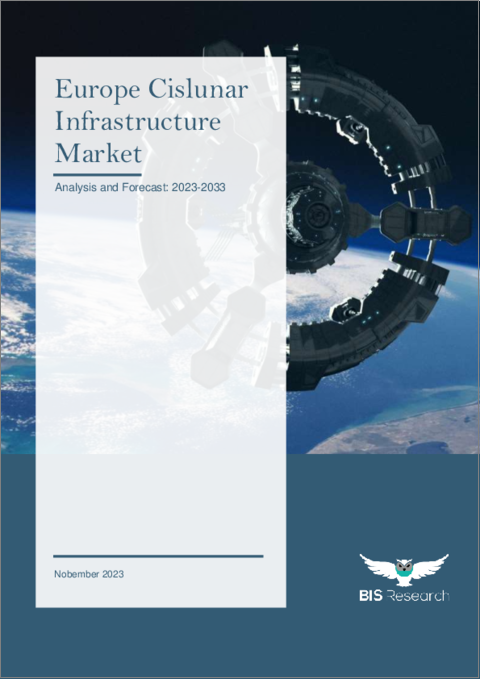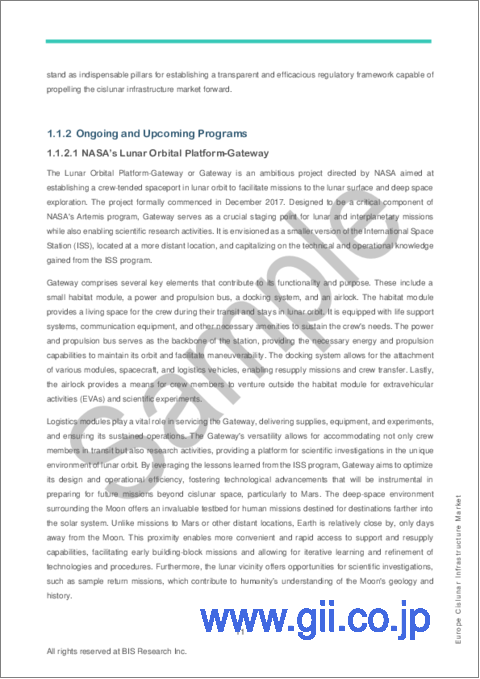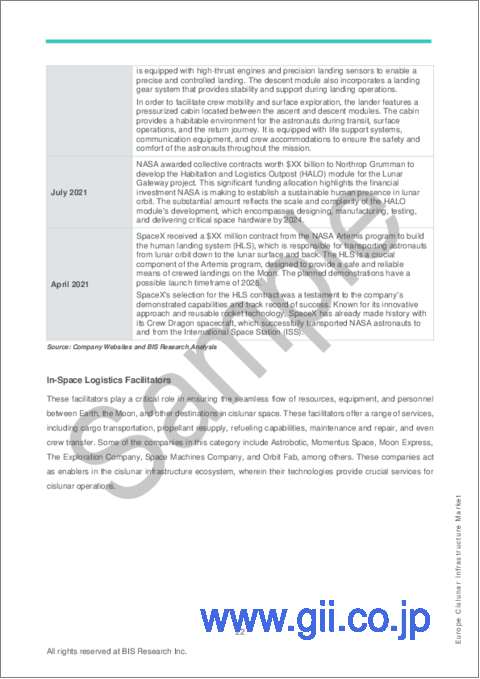|
|
市場調査レポート
商品コード
1389577
欧州のシスルナインフラ市場: 分析と予測(2023年~2033年)Europe Cislunar Infrastructure Market - Analysis and Forecast, 2023-2033 |
||||||
カスタマイズ可能
|
|||||||
| 欧州のシスルナインフラ市場: 分析と予測(2023年~2033年) |
|
出版日: 2023年11月30日
発行: BIS Research
ページ情報: 英文 66 Pages
納期: 1~5営業日
|
全表示
- 概要
- 図表
- 目次
欧州のシスルナインフラの市場規模は、2022年の11億9,000万米ドルから2033年には50億1,000万米ドルに達すると予測され、予測期間の2023年~2033年の成長率は12.80%になるとみられています。
月探査や地球周回軌道を超えた商業ベンチャーへの関心が高まるにつれ、シスルナインフラ市場は急速に宇宙産業の最重要分野のひとつになりつつあります。地球と月の間の領域は「シスルナ空間」と呼ばれ、さまざまな宇宙ミッションや活動をサポートするインフラを構築する上で、特別な機会と問題を提供しています。推進システム、宇宙ステーション、通信システム(中継衛星)、宇宙輸送システムが、二スラー宇宙インフラ市場の主な市場カテゴリーです。
| 主要市場統計 | |
|---|---|
| 予測期間 | 2023年~2033年 |
| 2023年の評価額 | 15億米ドル |
| 2033年予測 | 50億1,000万米ドル |
| CAGR | 12.8% |
推進システム、通信システム、宇宙ステーション、宇宙輸送システム、資源利用は、欧州の太陽系インフラ事業を推進する重要な要素です。推進システムと通信システムは、技術開発への大規模投資のおかげで進歩しました。しかし、この産業が存続できるかどうかは、宇宙ステーション、宇宙空間内輸送システム、資源利用の改善にかかっています。これらのセクションは、より長いミッション、持続可能な有人滞在、地球軌道を超えた月資源利用のために不可欠です。
欧州のシスルナインフラ市場は、宇宙機関、民間企業、国際パートナーシップからの関心の高まりの結果、拡大しています。再使用型ロケットの信頼性と推進技術の向上により、この分野は大きな成長を遂げています。通信ネットワークの信頼性と宇宙輸送ソリューションへのニーズの高まりは、主要な利害関係者によって取り組まれています。
長期的な月探査、科学研究、将来的な他の惑星への宇宙旅行を促進するためには、住居、月着陸船、資源抽出システムを含む、月面のインフラ構築が不可欠です。このインフラによって、安全な運用、効果的な資源利用、現在の宇宙資産やネットワークとの統合が可能になります。
当レポートでは、欧州のシスルナインフラ市場について調査し、市場の概要とともに、地域別の動向、および市場に参入する企業のプロファイルなどを提供しています。
目次
第1章 市場
- 業界の展望
- ビジネスダイナミクス
第2章 欧州
- 太古のインフラ市場(地域別)
- 欧州
- 市場
- 製品
- 欧州(国別)
第3章 市場-競合ベンチマーキングと企業プロファイル
- 競合ベンチマーキング
- 主要参入企業のプロファイル
第4章 調査手法
List of Figures
- Figure 1: Cislunar Infrastructure Market, $Billion, 2022-2033
- Figure 2: Cislunar Infrastructure Market (by Technology), $Billion, 2022 and 2033
- Figure 3: Cislunar Infrastructure Market (by Region), $Billion, 2033
- Figure 4: Supply Chain Analysis
- Figure 5: Value Chain Analysis
- Figure 6: Cislunar Infrastructure Market, Business Dynamics
- Figure 7: Share of Key Market Developments, January 2020- June 2023
- Figure 8: Competitive Benchmarking
- Figure 9: Research Methodology
- Figure 10: Top-Down and Bottom-Up Approach
- Figure 11: Assumptions and Limitations
List of Tables
- Table 1: Startups and Investments, January 2020-June 2023
- Table 2: Category of Launchers and Lunar Lander Facilitators
- Table 3: Launchers and Lunar Lander Facilitators Developments
- Table 4: Category of In-Space Logistics Facilitators
- Table 5: Category of Cislunar Communication Providers
- Table 6: Mergers and Acquisitions, January 2020- June 2023
- Table 7: Partnerships, Collaborations, Agreements, and Contracts, January 2020-June 2023
- Table 8: Cislunar Infrastructure Market (by Region), $Billion, 2022-2033
- Table 9: Europe Cislunar Infrastructure Market (by Technology), $Billion, 2022-2033
- Table 10: France Cislunar Infrastructure Market (by Technology), $Billion, 2022-2033
- Table 11: U.K. Cislunar Infrastructure Market (by Technology), $Billion, 2022-2033
- Table 12: Rest-of-Europe Cislunar Infrastructure Market (by Technology), $Billion, 2022-2033
- Table 13: Key Player Profiles
“The Europe Cislunar Infrastructure Market Expected to Reach $5.01 Billion by 2033.”
Introduction to Europe Cislunar Infrastructure Market
The Europe cislunar infrastructure market is estimated to reach $5.01 billion by 2033 from $1.19 billion in 2022, at a growth rate of 12.80% during the forecast period 2023-2033. As interest in lunar exploration and commercial ventures beyond Earth's orbit grow, the market for cislunar infrastructure is quickly becoming one of the most important segments of the space industry. The area between Earth and the Moon is known as "cislunar space," and it offers special opportunities as well as problems for building infrastructure to support a range of space missions and operations. Propulsion systems, space stations, communication systems (relay satellites), and in-space transportation systems are the main market categories in the cislunar infrastructure market.
Market Introduction
| KEY MARKET STATISTICS | |
|---|---|
| Forecast Period | 2023 - 2033 |
| 2023 Evaluation | $1.50 Billion |
| 2033 Forecast | $5.01 Billion |
| CAGR | 12.8% |
The propulsion systems, communication systems, space stations, in-space transit systems, and resource utilization are critical components that drive the European cislunar infrastructure business. Propulsion and communication systems have advanced thanks to large investments in technology development. However, the viability of the industry depends on improvements in space stations, in-space transit systems, and resource use. These sections are essential for longer missions, sustainable human presence, and lunar resource usage beyond Earth's orbit.
The market for cislunar infrastructure in Europe is expanding as a result of growing interest from space agencies, commercial enterprises, and international partnerships. Thanks to improvements in reusable launch vehicle reliability and propulsion technology, the sector has experienced significant growth. Reliability in communication networks and the increasing need for in-space transportation solutions are being addressed by major stakeholders.
To facilitate long-term lunar expeditions, scientific research, and prospective future space trips to other planets, the building of cislunar infrastructure-including dwellings, lunar landers, and resource extraction systems-is vital. This infrastructure enables safe operations, effective resource usage, and integration with current space assets and networks by addressing the particular problems and requirements of the cislunar environment.
Market Segmentation:
Segmentation 1: by Technology
- Propulsion Systems
- Communication Systems (Relay Satellites)
- Space Stations
- In-Space Transportation Vehicles
Segmentation 2: by Region
- Europe - France, U.K., and Rest-of-Europe
Europe is the highest-growing market among all the regions registering a CAGR of 12.80%. Europe is anticipated to gain traction in terms of cislunar infrastructure developments owing to the presence of a large number of cislunar infrastructure players and multiple international collaborations. Europe Space Agency (ESA) is a key collaborative partner in all the major cislunar infrastructure developments, including NASA's Artemis program, Roscosmos's Luna program, and China's International Lunar Research Station (ILRS) program.
How can this report add value to an organization?
Product/Innovation Strategy: The study provides the reader with a detailed understanding of the cislunar infrastructure market by technology, inclusive of the key developments in the respective segments in the European region.
Growth/Marketing Strategy: The cislunar infrastructure market has seen some major development by key players operating in the market, such as partnership, collaboration, and joint venture. The favored strategy for the collaboration between government space agencies and private players is primordially contracting the development and delivery of the key segments of the cislunar infrastructure ecosystem.
Methodology: The research methodology design adopted for this specific study includes a mix of data collected from primary and secondary data sources. Both primary resources (key players, market leaders, and in-house experts) and secondary research (a host of paid and unpaid databases), along with analytical tools, are employed to build the predictive and forecast models.
The key cislunar infrastructure players present and operating in Europe are:
|
|
Table of Contents
1 Market
- 1.1 Industry Outlook
- 1.1.1 Cislunar Infrastructure Market: Overview
- 1.1.2 Ongoing and Upcoming Programs
- 1.1.2.1 NASA's Lunar Orbital Platform-Gateway
- 1.1.2.2 ESA's Moonlight Initiative
- 1.1.2.3 ULA Cislunar-1000
- 1.1.2.4 China National Space Administration's (CNSA) International Lunar Research Station (ILRS)
- 1.1.2.5 CSA's Lunar Exploration Accelerator Program (LEAP)
- 1.1.3 Startups and Investment Landscape
- 1.1.4 Supply Chain Analysis
- 1.1.5 Value Chain Analysis
- 1.2 Business Dynamics
- 1.2.1 Business Drivers
- 1.2.1.1 Demand for Lunar Resources
- 1.2.1.2 Strategic Importance of Cislunar Space
- 1.2.2 Business Challenges
- 1.2.2.1 Cislunar Regulations
- 1.2.2.2 Challenges in Energy Collection and Distribution for Cislunar Infrastructure Requirements
- 1.2.2.3 Constraints in International Partnership
- 1.2.3 Business Strategies
- 1.2.3.1 Mergers and Acquisitions
- 1.2.4 Corporate Strategies
- 1.2.4.1 Partnerships, Collaborations, Agreements, and Contracts
- 1.2.5 Business Opportunities
- 1.2.5.1 Need for Situational Awareness and Communications Infrastructure
- 1.2.5.2 Inter-Orbital Transportation and Cislunar Surface Transportation
- 1.2.5.3 Requirement for On-Orbit Servicing
- 1.2.1 Business Drivers
2 Europe
- 2.1 Cislunar Infrastructure Market (by Region)
- 2.2 Europe
- 2.2.1 Market
- 2.2.1.1 Key Players in Europe
- 2.2.1.2 Business Drivers
- 2.2.1.3 Business Challenges
- 2.2.2 Product
- 2.2.2.1 Europe Cislunar Infrastructure Market (by Technology)
- 2.2.3 Europe (by Country)
- 2.2.3.1 France
- 2.2.3.1.1 Market
- 2.2.3.1.1.1 Key Players in France
- 2.2.3.1.2 Product
- 2.2.3.1.2.1 France Cislunar Infrastructure Market (by Technology)
- 2.2.3.1.1 Market
- 2.2.3.2 U.K.
- 2.2.3.2.1 Market
- 2.2.3.2.1.1 Key Players in the U.K.
- 2.2.3.2.2 Product
- 2.2.3.2.2.1 U.K. Cislunar Infrastructure Market (by Technology)
- 2.2.3.2.1 Market
- 2.2.3.3 Rest-of-Europe
- 2.2.3.3.1 Market
- 2.2.3.3.1.1 Key Players in the Rest-of-Europe
- 2.2.3.3.2 Product
- 2.2.3.3.2.1 Rest-of-Europe Cislunar Infrastructure Market (by Technology)
- 2.2.3.3.1 Market
- 2.2.3.1 France
- 2.2.1 Market
3 Market - Competitive Benchmarking & Company Profiles
- 3.1 Competitive Benchmarking
- 3.2 Key Player Profiles
4 Research Methodology
- 4.1 Factors for Data Prediction and Modeling






